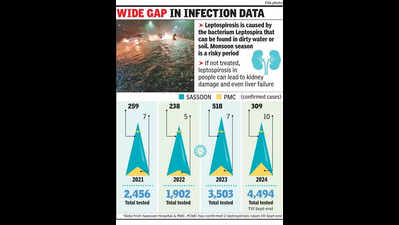Pune: A total of 309 leptospirosis patients. That's how many the city's Sassoon General Hospital confirmed till Sept this year. In fact, 275 of these cases were recorded within just four months — from June to Sept.
But numbers with Pune Municipal Corporation and Pimpri Chinchwad Municipal Corporation don't reflect the surge at Sassoon, of a disease that usually spikes during a heavy monsoon. Till Sept, PMC had confirmed 10 cases, and PCMC two. Sassoon's higher count is possible as it's one of the district's largest tertiary care centres.
However, since several of its leptospirosis patients have been from either Pune or Pimpri Chinchwad (according to doctors there), it's surprising the civic bodies have confirmed such low numbers. Humans can get leptospirosis if they come in contact with dirty water or soil, or infected animal urine. The disease then can spike in communities affected by high rodent populations, congested living conditions, flooding and improper drainage.
A clean city is critical to prevention, experts said. When asked about the gap in data — more than 300 patients at Sassoon while only 10 confirmed cases with PMC — one civic official said: "PMC wasn't informed about leptospirosis cases at Sassoon. The hospital is supposed to inform us.
"Calls and texts to PMC health chief, Dr Neena Borade, went unanswered. Dr Yallapa Jadhav, Sassoon's medical superintendent, said their tally has been sent to the state's Integrated Disease Surveillance Programme. "Samples .


















